

 The Accurate Reloading Forums
The Accurate Reloading Forums  THE ACCURATE RELOADING.COM FORUMS
THE ACCURATE RELOADING.COM FORUMS  Guns, Politics, Gunsmithing & Reloading
Guns, Politics, Gunsmithing & Reloading  Reloading
Reloading  Bullet Seating Depth is THIS CRITICAL???
Bullet Seating Depth is THIS CRITICAL???Go  | New  | Find  | Notify  | Tools  | Reply  |  |
One of Us |
Don't be too harsh on us! We tried but most of us are hoping to learn from this thread, I would think. I am greatful that you raised the issue since the outcome is of value to me - thank you! Thank you again for the very informative thread! Regards 303Guy | |||
|
| One of Us |
Next time you talk to Ricky tell him I taught him everything he knows. I am sorry I can't help on this. I can usually get my match rifles to shoot 1/2 to 5/8 minute pretty easily, I then practice positions and hold, that is where I get most of my gain. On my hunting rifles I shoot for a minute or less and then practice offhand or on shooting sticks. I never had the patience to be that meticulous. My experience with SMK is 010 to 015 work fine. I once had an AR 15 match rifle I shot so much a 69 grain bullet would fall out of the case whe using a Stoney Point gage and it still shot 1/2 minute. Those matches at Raton surely sound interesting. BTW I am sure Ricky was referring to Carroll G. | |||
|
One of Us |
Now that is insulting. I don't know what you were expecting to hear. Many here have stated that seating depth is just one of many factors but you obviously don't want to take that as constructive. Were you just expecting "OMG, you're right!!" kinda crap. You need to re-read your own thread and re-evaluate your be-all-end-all epiphany
Every gun is different and what works in your gun will not necessarily work in any other. Two years from now when you look back and figure out that your great epiphany about seating depth was a crock of chit, we will all deserve an apology, although I doubt we will get it. ____________________________________ There are those who would misteach us that to stick in a rut is consistency - and a virtue, and that to climb out of the rut is inconsistency - and a vice. - Mark Twain | Chinese Proverb: When someone shares something of value with you and you benefit from it, you have a moral obligation to share it with others. ___________________________________ | |||
|
| One of Us |
I was always taught that if you didn't have something constructive to say, then keep your mouth shut, which is what I have tried to do on this thread. You see, it seemed to me you were getting sound advice, but it was falling on deaf ears. But since you have practically called out the whole board on this deal, then I'll go ahead and jump in. Read Woods last post, then read it again. It contains information from several different posters and taken all together is probably some of the best advice on bullet seating depth I have heard. Back in the early 90's I decided that the way to get the most accuracy out of my rifles was to load the way the bench crowd did it. Turns out I was wrong, 'cause my rifles weren't bench guns and didn't respond the same way. There were too many variables in them, unlike the firing line at a bench match when you have 20 rifles in a row all as close to perfection as a rifle can be made. While listening to that class of shooters is good, the techniques that work in their rifles may end up having you chasing your tail with your factory A-bolt. In my experience, it is best to back off the lands .020 to .030 and find a bullet and charge weight that works well. Then play with some of the other variables such as seating depth and primers. You begged for input, that's mine. | |||
|
| One of Us |
I'll offer it to you now then Woods, and anybody else who is offended. Sorry. I appreciate the quotes and obviously there is some intelligent input. I have been very frustrated with this issue and it peaked last night when I wrote the last post. You'll notice though that all of the input does not really address the order in which things are done when developing an accurate load. That's basically what my epiphany is all about. There are many posts saying "this effects that" and "I start with this depth" or "varying the depth is like a barrel tuner" etc. Nobody has talked with me about the actual step by step order and reasons for doing them in that order. Maybe I wasn't clear that that is what I'm after. It seems to me by finding the depth your gun likes the bullet to be seated at FIRST, will result in firing less ammo to find the most accurate charge weight. It also seems to me that perfectly good combinations of bullet/powder would not be overlooked during load development if this seating depth is a "known parameter" before firing loads with varying charge weights. This is absolutely true in my case | |||
|
| One of Us |
There's the rub! Your case is your case only. Each gun is different. That's the way it is. One gun can be picky as hell about seating depth. the next one off the same production line might not matter at all. That's why you tune loads for one gun. Yeah, there's a lot of loads that work well in lots of guns, but until someone discovers the rule that applies so that we can make three measurements and load up a box of 1/2 minute rounds for every gun, we'll all have to just keep mucking about blindly. | |||
|
| One of Us |
Not a problem. I look at it as having a bucket with several holes in it, and you are trying to fill the bucket with water. You have to plug the lowest holes first, or you never get up to the higher ones. To me, seating depth is one of the higher holes, at least usually. I want to plug the lowest holes first which are usually bullet, powder, and charge weight. Now there are instances where a bad seating depth can give erratic results when you are trying to do a ladder. Generally to me it seems this is when you are trying to play in that just touching to .015 off the lands range, and it seems this is the range you were in when you did your initial test. I think if you had backed off that seating depth some to begin with, your ladder would have been more meaningful. In other words, you started you test in a range many precision reloaders consider to be "iffy", and where you can get inconsistent results. Not always, but can. And I can understand frustration with loading issues, all of us have been there before also. | |||
|
| One of Us |
Thanks JTPinTX. See, your reply actually makes sense and does a lot to answer my original question. My question was a general one about the order in which processes were done and if it mattered. I thought I found out that it did and that we were possibly doing things out of order. Woods quote: " Were you just expecting "OMG, you're right!!" kinda crap. You need to re-read your own thread and re-evaluate your be-all-end-all epiphany" No Woods, I was hoping to get replies like this: "No, you're completely wrong! You should find the seating depth AFTER you find the best charge weight BECAUSE......1, 2, 3." OR: "Hey, maybe you're right! It makes sense that you should know the seating depth before charge weight testing BECAUSE OF...1, 2, 3." Woods, please tell me how the following posts address my question............... ------------------------------------------------ quote: Correct me if I'm assuming something I shouldn't, but your recent revelation concerning seating depth is one 3 shot group? I'd be more inclined to believe you've found a really good recipe for that rifle if you came back here after shooting 5 such groups on 5 different days. That would be a true test. Statistically speaking, one 3 shot group is equivalent to, pardon my french, shit luck. ------------------------------------------------ quote: With new cases the firing pin will push the case forward in the chamber until it is stopped at the shoulder or belt. That amount of headspace can vary according to your chamber and brass. If you have .015" of headspace on a new case then seating .015" off the lands will be essentially the same as seating on the lands." ------------------------------------------------ quote: What you are actually doing is making the bullet exit the barrel at the sweet spot in much the same way that barrel tuners work. A bullet that exits the muzzle at either a peak or valley of the harmonics curve will be consistently more accurate than one exiting on the way up or down from the peaks." ------------------------------------------------ "!!!!!20 shot ladder test????? " ------------------------------------------------ "I think this thread shows how one --usually a rag writer, desperate to fill up inches-- can take a single facet of reloading for accuracy and try to make a doxology out of it" ------------------------------------------------ woods one of us Posted 24 February 2009 18:35 Hide Post You also have to keep in mind that even if you load at the same OAL, the distance to the lands is subject to change. With new cases the firing pin will push the case forward in the chamber until it is stopped at the shoulder or belt. That amount of headspace can vary according to your chamber and brass. If you have .015" of headspace on a new case then seating .015" off the lands will be essentially the same as seating on the lands. Once fired, twice fired and sometimes 3 times fired brass will still have a certain amount of headspace before the case has expanded enough to get a crush fit into the shoulder. Until then the distance to the lands will be moving, even though a much smaller amount than with new cases. Throats will recede with repeated firings. How much will depend upon the type of powder and how hot your gun gets during firing sessions. If you load 100 cases all the same OAL, chances are that the last 10 you shoot will have a .005" or greater distance to the lands than the first 10 you shoot. _______________________________________ Guns only have two enemies; rust and politicians ------------------------------------------------ I'm just looking for a discussion on the question I asked, not for people to spew out everything they have learned about subjects in reloading that have nothing to do with my question. Maybe it's my fault in the way I posed the question but I thought it was pretty clear. Also, people can read the same written words and derive many different meanings from them. I never meant to offend. I don't make arrows out of pointed words, but it seems from the increase in good replies if you want to make an omlette, you have to break some eggs. | |||
|
| One of Us |
Woods.... Nice "verbal beat down" you dished out by the way. | |||
|
| One of Us |
Why you seldom get a "writ in stone" answer to many of your reloading questions is that often they do not have any really wrong answers, nor right answers. Assuming that the parameters of safety are observed. Were you to ask: How do you go about developing a load? Many of the responses would begin with "the way I do it is...." So if you want to establish the ideal cartridge length first, that's fine. But the moment you change the powder load, perhaps the ideal cartridge will change. The stool shooters I know, to a man, seat their bullets, actually jam their bullets, into the lands. Some to the point that the rifle chamber is cut so tight that they don't resize their cases and just start their bullets into the case with their fingers and let bolting the round home seat the bullet. One certainly doesn't need to worry too much about case run out that way but I fail to see a real world, hunting advantage to that technique. | |||
|
| One of Us |
Thanks stillbeeman. I've been back through every post on this thread and read every word over and over. I'm understanding some of where they're coming from a little better now. I guess there is no chiseled in stone method. One gentleman posted that he experienced the same problems as me with load development with the initial test loads seated too close to the lands. The range he stated was from the jam to .015" off and he recommended around .030 as giving the best results. So, I've learned some things from the input on this topic and from my own experience. The things I've learned will definitely change my load development for the better and I hope they help anybody else who has read the posts on the thread. My own findings have affected me so dramatically that I will from now on during load development: 1. Shoot some groups with the bullet loaded at a charge weight around 5% below the max load, varying only the seating depth to at least find a seating depth range that won't end up messing up a ladder. I've learned that this seating depth will also probably have to be adjusted after I: 2. Shoot a ladder, pick a node with some consecutive shots that look like they will yield an accurate load, and load the cartridges. It will have to be adjusted because it will most likely not be the same charge weight as the 5% below max tested loads that I picked that seating depth from. I've learned that every charge weight may need a different seating depth for best accuracy because of the change. If anyone has anything else to add, please do. Thanks for all your posts. I do mean ALL. It's been an enlightening experience. | |||
|
One of Us |
Hey rc, perhaps an illustration through example: Epiphany #1 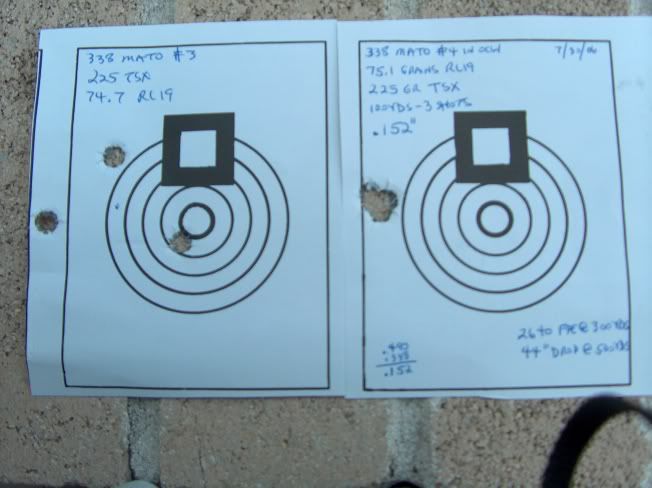 When you have an extra large group, .4 grains more will always be superb! Epiphany #2 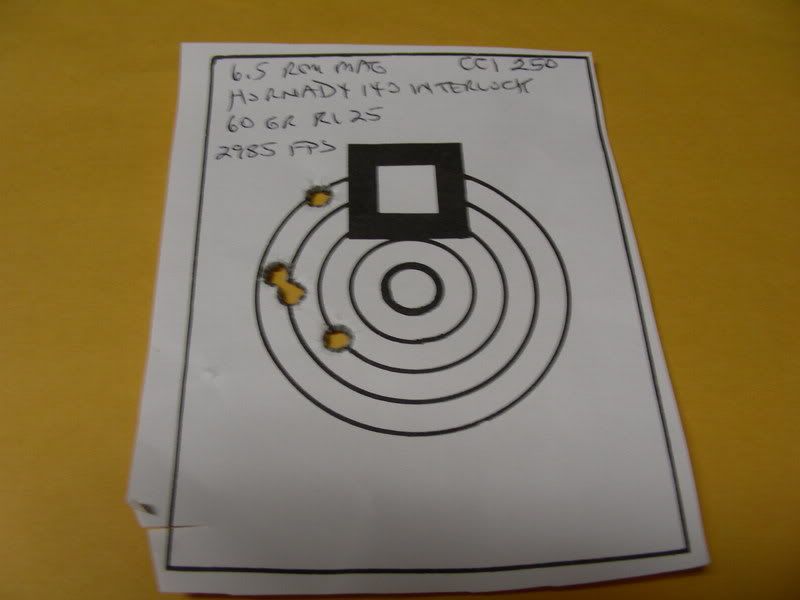 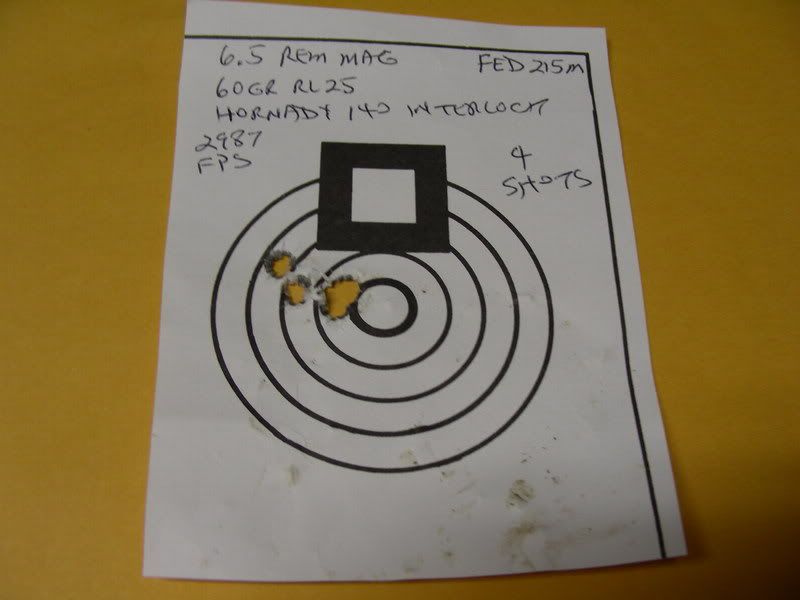 Fed215M primers will always yield smaller groups than CCI250's! Epiphany #3 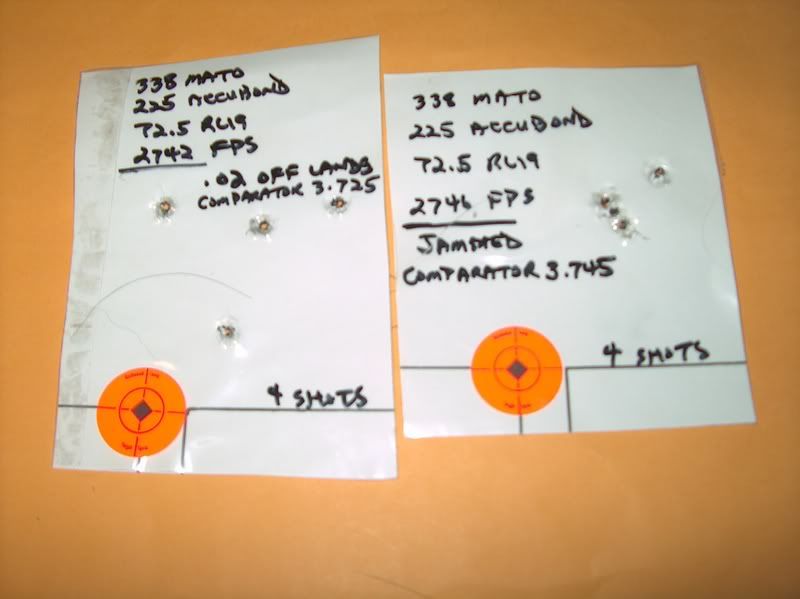 Jamming bullets will always work better than seating .020" off! Epiphany #4 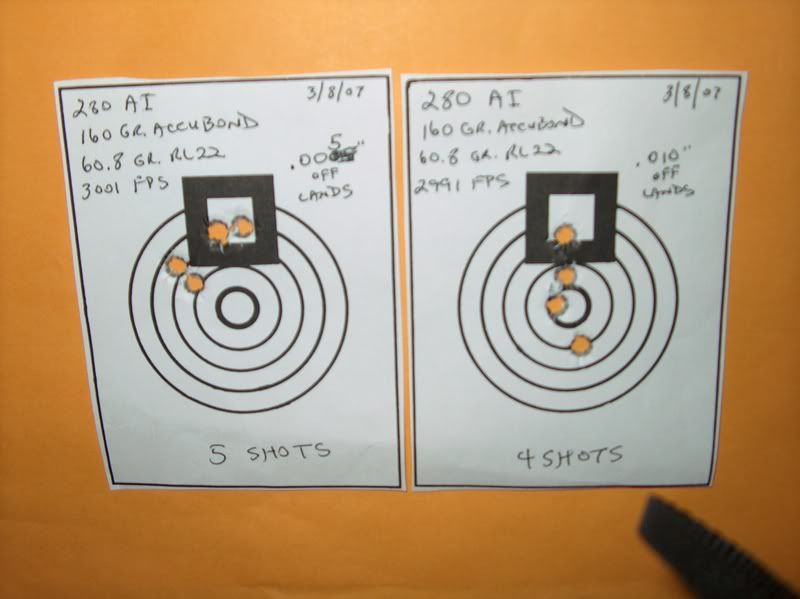 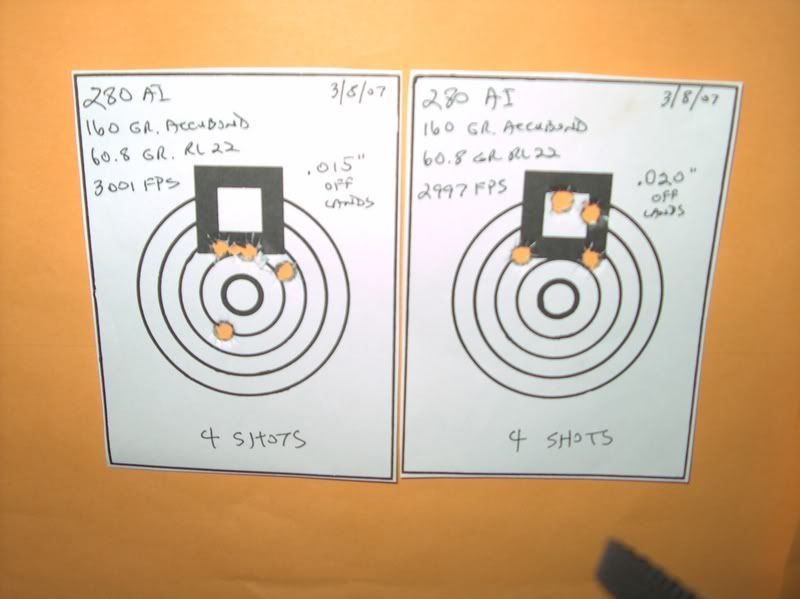  Changing seating depth will not change groups size much but it will change the general placement of the group on the target! Epiphany #5 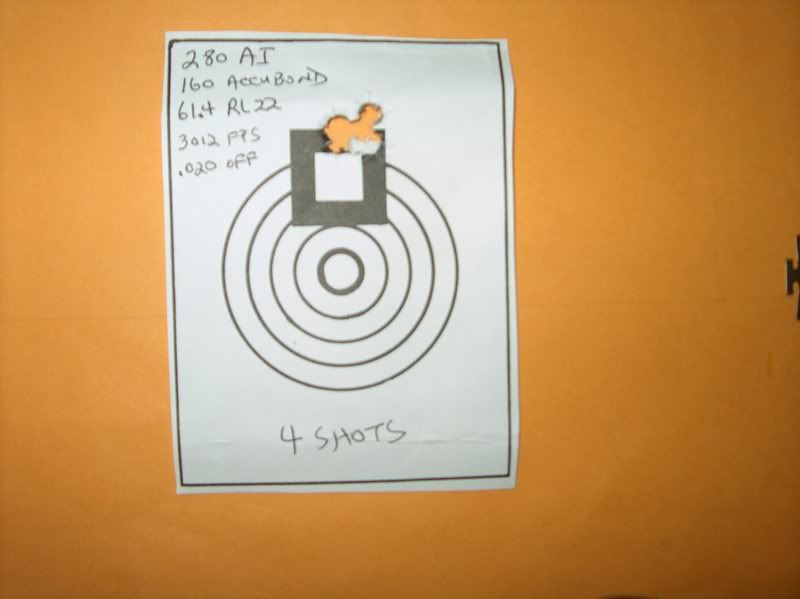 Powder charge is much more important than seating depth (notice target in middle in Epiphany #4 is the same seating depth) than seating depth! Shall I go on? The point is that you need to bring a lot more data before a conclusion could be reached that what you experienced is anything more than an anomaly specific to your rifle at this particular time. Then maybe we could consider throwing away the time tested Audette method and the (forgive me HC) the OCW method of finding loads and the conventional wisdom of a ladder in powder weight first. Do a test in 5 different rifles and document the powder and seating depths and we'll talk. ____________________________________ There are those who would misteach us that to stick in a rut is consistency - and a virtue, and that to climb out of the rut is inconsistency - and a vice. - Mark Twain | Chinese Proverb: When someone shares something of value with you and you benefit from it, you have a moral obligation to share it with others. ___________________________________ | |||
|
| One of Us |
Wow Woods! You certainly have a lot of experience with reloading and this subject in particular! Why didn't you share this info earlier in the thread? It would have saved me and everybody reading it a lot of headache. I see where you are going with this though. Just because I seem to have found something that improves the way a rifle shoots doesn't mean that it can be applied to EVERY RIFLE. Why did you have to put words to your pictures in such a condescending way? It makes sense though, and I think I stated that "it just might be my rifle" many times during the thread if you take the time to look back. I don't know where you came up with the notion that I somehow want to throw away the ladder test or the OCW method. I use ladders all the time and clearly state many times during the thread that my revised method of load development will still utilize them. Hey Woods! From the tone of your posts, I'll bet your a Trap Shooter! Either that or rifle shooters like you are just like Trap Shooters.................................................................. | |||
|
One of Us |
I don't think so. Most of what I posted in my recent thread doesn't prove or disprove your results. Actually the point is that my results don't prove anything either, only what happened at that particular time in that particular rifle.
My turn to apologize. I promise I will not be condescending if you promise not to infer that I (or others who posted here whose opinions I respect) are not knowledgeable and don't post intelligently. Ladder tests like Audette or OCW vary the powder weight first, so if you use these methods then that is what you would normally do. I would think that if you used the Audette method to choose a powder weight first then in all likelihood you could then vary the seating depth and not change the correctness of the powder charge selected by the method. However, if you chose the seating depth first and then ran the Audette, the seating depth correctness might change with the variance in powder charge. Trap? I've been know to shoot off my trap before (just ask HC) but not to trap shoot. Does that mean you had a bad experience with a trap shooter before? I only shoot hunting rifles with hunting loads and hunting bullets from 22-250 to 338 RUM. No BR, no trap. ____________________________________ There are those who would misteach us that to stick in a rut is consistency - and a virtue, and that to climb out of the rut is inconsistency - and a vice. - Mark Twain | Chinese Proverb: When someone shares something of value with you and you benefit from it, you have a moral obligation to share it with others. ___________________________________ | |||
|
| One of Us |
Thanks Woods. I understand that the ladder test and all the others you speak of are tests that normally only test the varied powder charges. BUT........AND HERE WE GO AGAIN..........I'll be very specific....... In the gun I tested I seated the bullets for the test like I normally do...... .010" from the lands. The gun will not shoot ANY CHARGE LOAD WITH THAT BULLET IN SOMETHING YOU WOULD CONSIDER A "GROUP" at this seating depth. I would classify it more as a "Pattern". When the bullet is seated at a depth it likes, it shoots well and "groups". Using my power of deductive reasoning, I concluded that it was impossible to pick a load from the ladder shot with the bullet seated improperly because THE SEATING DEPTH EFFECTED THE WAY THE GUN WOULD GROUP. I've settled on the idea that the bullet must be seated at some depth that will "group" with a charge used in the ladder test or the other methods. If not, the results of the test will be meaningless because the gun will "pattern" and not "group" because of seating depth effects Other posters to this thread have mirrored this by saying that their guns didn't like the bullet to be seated too close to the lands and that they felt it effected their load development as well. I really want you to understand what I'm talking about and if it still doesn't make sense let's keep plugging away at this. I won't give up unless you do. Is there any other way I can describe this? | |||
|
One of Us |
One of my posts
another of my posts
Posted by JTPinTX
Another post by JTPinTX
Posted by CoyoteKiller82
Posted by Jim C. <><
I would say that the point was made that it is best if you load a good distance off the lands when doing a ladder for powder weight. Once you find the powder weight then that can be further improved by seating depth testing. On the other hand if you pick a powder weight and do a ladder for seating depth then when you pick your best results for seating depth and then do a ladder test for powder, all will change. I do understand and you can certainly do the tests anyway you want, personally I'll do the powder test first at a seating depth >.020". In retrospect I would also say that what you have discovered about your rifle, powder, case primer, type of prep and bullet is that this combination does not work well when seated close to the lands. Change anything and that has a good possibility of changing the best seating depth. To me, seating depth is the least sensitive variable as long as you are >.020" (and I would just pick .030" and go with it). ____________________________________ There are those who would misteach us that to stick in a rut is consistency - and a virtue, and that to climb out of the rut is inconsistency - and a vice. - Mark Twain | Chinese Proverb: When someone shares something of value with you and you benefit from it, you have a moral obligation to share it with others. ___________________________________ | |||
|
| One of Us |
Roger Wilco OVER AND OUT............................. | |||
|
One of Us |
This has been a very informative thread to me - I have learned a thing or two. Thanks for the thread, rcamuglia. Regards 303Guy | |||
|
| One of Us |
Thank you very much! It was stressful to me to say the least. It consumed me for some time and I was frustrated about the replies I received. I was just trying to learn as well 303Guy.......or help someone else with something I thought I found out that could be applied universally to our reloading methods. I think the back and forth between me and some of the posters were misunderstandings on both our parts. I'm glad someone other than me got something out of it! | |||
|
One of Us |
You're welcome! (I feel quite humbled by the knowledge, experience and skills of the folks on this forum!) Regards 303Guy | |||
|
| One of Us |
I do as well. There are definitely some folks who are experts and are more than willing to help. What I don't like, and nobody does, is when a question is posed to an "expert" the answer comes back in a condescending, pompous manner meant to demean or belittle the person for asking it and show how superior their knowledge is. There's a few of them on these forums too. | |||
|
| One of Us |
I think you'll find, the attitude and tone of the questioner often determines the tone and attitude of the respondents. Case in point, its not too wise to take the respondents to task because they do not stay strickly on narrow task in answering your questions nor become belligerant if they don't agree with you. Perhaps if it was your very own forum......... | |||
|
| One of Us |
Thank you for your thoughtful reply slancey. The more I've digested the replies, the more I'm believing that load development must be done with the bullet seated around .030" off of the lands as Woods suggested. It probably works in most rifles. The only thing I see wrong with this notion is what happens if you have a gun that shoots every combination of powder and bullet that is seated .030" off of the lands poorly and you don't realize it's the seating depth that is the problem? Do you disregard that bullet/powder combo under the assumtion that the seating depth of .030 should be fine for all guns including the one you are testing? Maybe a different depth at the development of the load that the gun likes would let you find an accurate load with that bullet/powder combo. It sure would save a lot of time and money buying different powders and bullets. That's why I figured finding a depth that works first would be the way to go. Load something safe in the middle of the charge weights suggested and just vary the depth to see if the gun will shoot a decent group with the bullet you chose, then, with that seating depth info, shoot different charges or a ladder to choose an accurate, higher velocity load. If nothing in reloading is chiseled in stone, then why should "start load development with a bullet seating depth of 'X'" be? Maybe that bullet seating depth is great for 99% of the rifles? I don't have the experience to know. In my rifle, finding the seating depth worked and saved me from having to change another component. It didn't work with my normal load development depth of .010" off of the lands which has worked in all the other rifles I own............ | |||
|
| One of Us |
10-4 stillbeeman, I thought that a little cage-rattling or stick-poking would help. I was wrong and have apologized. I've saved this info for future reference too. It's interesting though that the 'Alan DeGroot' reference was like stirring up a bee hive! | |||
|
| <slancey> |
Your experience made me realize something I was missing in my own load development. That is that if I start with the bullet very close to the lands, that is, 5 or 10 thousandths, or even touching the lands, and work up the powder charge, I may actually get high pressure signs before book maximum. This means I'm not seeing all that a bullet can do at the higher velocities. I at least have to start my load development with the bullet seated deeper than I do now. I think cartridge class has something to do with this decision. I load a lot of .223 class cartridges in varmint style guns. They work really well seated at .010" off the lands or closer. I didn't read what class of cartridges you are loading. | ||
|
| One of Us |
The gun I was loading for was a .243 WSSM. I agree with your findings that pressure is too high if the bullet is too close. I will be loading for a .264 win mag this week and my first attempts sucked because of this I think. I didn't get the velocity and pressure was maxed. I will back the bullet off on my next attempts. Thanks for confirming my suspicions | |||
|
| One of Us |
Actually, this is one of the hottest topics in target shooting. Specifically as it relates to VLD--very low drag--bullets which tend to be cranky about seating. I lifted this post from the Long Range forum, and I believe it was made by last year's NBRSA 600 yard Nationals champion, Jerry Tierney. Which means that unlike most of what we read on the boards, you can believe this. I also believe Berger has corraborated. "I got a shooter to try jumping Berger 115 VLDs in his 6-47. He said he did not believe me but would try jumping them. This morning he told me that he compaired in the lands to jumping 20-40-60-80-100-120 thousands. At 80 thousands jump he said his group size was reduced by 50% and he was able to get a very big increase in MV with NO pressure signs. This shooter was second by Xs in last years LR National Championships at Camp Perry. I have two 6MMs that I jump the Berger 95 VLDs at 90 thousands in one and the other likes 120 thousands jump. A couple of things that help the jumping accuracy is we use large neck clearances ( 4 to 10 thousands ) and tight throats. Testing also shows that case-bullet runout (tested with up to 12 thousands runout) doesn't have much effect on group size using the large neck clearance and tight throats. If you shoot tight neck rifles and seat the bullets at, just in or out of the lands the brass becomes very very important. I found that if you load VLDs into the lands the best groups are when the bullets are all loaded exactly the same amount in the lands. Due to seater, reloading press, neck tension and bullet ojive differences that is not an easy thing to do. I have tried several store bought tools and found that the do not measure to the same point as the bullet touches my lands. What I use is a one or two inch barrel stub short chambered with my reamer so I can measure both bullets and loaded rounds to control the oal. Jerry" The point is--and it's of limited utility--that there's an alternative to tight neck chambering and trying to maintain impossible tolerances in seating depth, and this is to shoot loose neck--typically sporter standards--chambers and jump the bullets. It is at any rate good news, but fails to answer your basic question. Personally, I believe it's best to evaluate for charge first, and then seating depth. flaco | |||
|
One of Us |
Good input flaco, but even though most factory rifles have the large neck clearances, it takes a custom chamber to have a tight throat. Good news though cause my 338RUM has a tight specifically chambered throat to go along with a tight neck. Maybe that's why it shoots the 225 gr TTSX seated .050" off so well 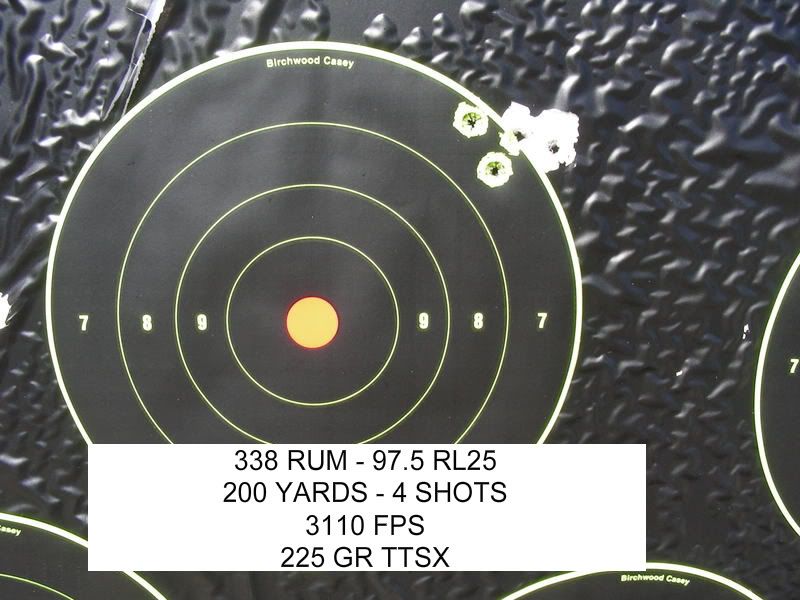 ____________________________________ There are those who would misteach us that to stick in a rut is consistency - and a virtue, and that to climb out of the rut is inconsistency - and a vice. - Mark Twain | Chinese Proverb: When someone shares something of value with you and you benefit from it, you have a moral obligation to share it with others. ___________________________________ | |||
|
| One of Us |
Talk to the ballistic technicians at Sierra Bullets. I talked about seating the bullet against the leade and one of them cringed. I still do it most of the time but.... The 6MM Remington is a tight fit in the short action 700 Remington. You can't normally reach the rifling with any bullet seated to fit the magazine. The old RN Hornady bullets get closer than the spitzers but none are really close. From what I can tell it does not matter. They still shoot about as well as any other rifles I have shot of similar quality. Then there is the Ruger 77 in 7X57 (they are long actions). Seat the light spitzer bullets way out or any place else and they are mediocre. Load a factory 175 grn RN and they shoot tiny groups. Loading is a lot about learning. | |||
|
One of Us |
Without getting a war started, have any other wssm shooters noticed how finicky they are? After helping a bud with his 223wssm, by the time we had a decent load developed, the barrel was shot out. I wonder now if seating too far off the lands could cause excessive throat erosion? "Earth First, we'll mine the other planets later" "Strip mining prevents forest fires" | |||
|
| One of Us |
Actually, woods, Tierney's post is followed by one by Eric Stecker of Berger. [I'd have linked, but one must register to read the thread.] I'm too lazy to quote Mr. Stecker directly, but it was the preponderance of data from hunters limited by magazine size to rounds that jumped that prompted Berger to re-evaluate their long-standing advice to jam, or at least touch the lands, with the VLDs. The devil, of course, is in the details, and nowhere more than precision reloading. Still, as I read it, folks with non-custom chambers may benefit by at least testing fairly long jumps. Best, as always woods, flaco | |||
|
| One of Us |
Great additions to the thread guys. Much appreciated. If we keep going like this, I'm sure something will sink into my skull full of mush! | |||
|
| One of Us |
Hey Wino, You may want to go to the wssm zone website for more info about the wssm's. | |||
|
One of Us |
A very informative post, flaco. Regards 303Guy | |||
|
| One of Us |
Rcamuglia, I quoted some pertinent points on what was said before. My answer is .... to each his own. Factory rifles with loose tolerances do make things more difficult than with precision made benchrest rifles, where chambers & throats are tight so the cartridge case fits the chamber like a handglove, being perfectly concentric and the line-up with the bore is 100%, and having fitted best grade custom-made match barrels makes a huge difference in the accuracy stakes. Mention was made of small groups at 300 yards, and for that we are already in a mini match competition scenario. Then we need to look at the bullet and to make sure the type of bullet is not plagued with imbalance. It is imperative to have a fine trigger pull that breaks clean and easy to avoid pulled-shots. If you do not have a scope that cut the bull at 300 yds into 4 quadrants than your point of aim will not be the same every time, and you need to have a steady and comfortable shooting rest and a natural sitting position. Shooting small groups at 300 yards can be a time consuming exercise, as it will mean plenty fiddling and many trips to the range. Seating depth in my opinion lies on a much lower level than the above factors. I have always started off with a 1 mm (0.06") gap off the lands with Softs and 1.5 mm (0.06") with Solids and it worked for me. Playing with the powder charge is much more important than seating depth imo. Right at the end of the process I will fiddle with seating depth, bringing it closer to the lands if need be. Generally if I can shoot 1/2-inch groups at 100 yds, I will not fiddle any further. Warrior | |||
|
| one of us |
"All of the shooting was done at 300 yards." To far IMO. 100yds with wind flags better. I like to seat the bullet base at the neck shoulder junction for starters. Run up the powder charge from light to maximum. Then change bullet seating depth. 5 shots each group. | |||
|
One of Us |
This is a good post..... /////////////////////////////////////////////////////////////////////////// "Socialism is a philosophy of failure, the creed of ignorance, and the gospel of envy, its inherent virtue is the equal sharing of misery." Winston Churchill | |||
|
| One of Us |
Wow! Talk about bringing an old thread back from the dead! | |||
|
| Powered by Social Strata | Page 1 2 |
| Please Wait. Your request is being processed... |
|
 The Accurate Reloading Forums
The Accurate Reloading Forums  THE ACCURATE RELOADING.COM FORUMS
THE ACCURATE RELOADING.COM FORUMS  Guns, Politics, Gunsmithing & Reloading
Guns, Politics, Gunsmithing & Reloading  Reloading
Reloading  Bullet Seating Depth is THIS CRITICAL???
Bullet Seating Depth is THIS CRITICAL???

Visit our on-line store for AR Memorabilia

